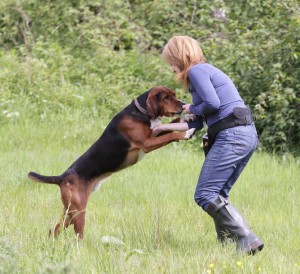Well I read the books and watched the DVDs. I've never been a great one for jumping into action, I'm more of a couch potato. Neil Sattin's DVDs provide a straight forward way of following Kevin's approach, offering simple techniques for you to follow when working with your dog.
I started on the first core exercise, 'pushing for food'. It looked simple, but I got into difficulty straight away and needed to go back to the DVD's to check technique and good advice from the NDT forum.
You need a good treat bag. Neil advises a nail pouch from a hardware store. His is a tasteful leather affair. To start the NDT training I got something a bit less stylish but just as functional from B&Q. I now give my dogs at least one of their two to three meals a day 'pushing for food'. Sometimes I wished I hadn't got into raw feeding because hand-feeding raw tripe is a bit smelly.
'Pushing for food' has been a great learning experience. It helped me get a better understanding of the dogs' different temperaments. I know three dogs are hard work but the differences that I saw when comparing their temperaments taught me a lot. Maybe people with more dogs have more to learn?
The pup Archie was up for it straight away. At 9 months old he could find no reason to not fully trust me and happily launched himself at me, a great way to get to his dinner. Sometimes I worry that he will do himself an injury, or me. It was later that I realised that breed is also relevant here. Labradors are much more puppy-like than other breeds.
Jack, at time of writing, was a 5 year old intact male, who was also with me from a puppy. He found the whole thing a good game and was fairly quick to push hard, although he tends to bring his great big paws into it, which can be a bit of a liability.
Neil Sattin advises getting the dogs' claws clipped before doing this. It is true that my arms were starting to look as if I was self-harming.
Logan was a bit more reluctant. He has had a few homes before he came to us, age 3.5 years. Previous owners believed he had been badly treated as a pup. He was quite uptight with a hair-trigger sensitivity to noise. He was a bit slower to get in to the pushing and was more likely to hold back unless he was in a very 'open-space' environment, like an open field. But we made progress. Neil also advises having the dogs on a long-line to make sure you don't lose them – welcome to my world! This I only did with Jack – a 60ft long-line at first. The other two I didn't bother but I was working a secure field that is fairly secure.
That's all there is to pushing for food. Progress next is to 'tug of war' and 'push of war'. Again each dog moved at their own pace, in direct correlation to the trust that they were willing to invest in me.
The biggest lesson for me was patience, patience, patience.....I can't wait to get that one sorted.









